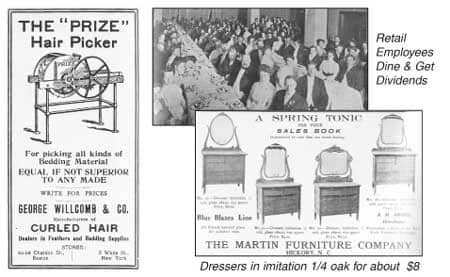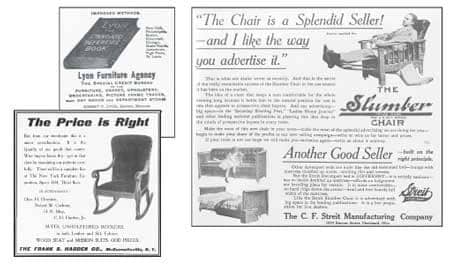
At the end of the first decade of the 20th century there were 91 million people living in the US, a major jump due to an increase in immigration. About 1/3 of the population lived in metropolitan areas led by New York, Chicago and Philadelphia. William Howard Taft was president.
First High Point Market:
Editor’s Note: 2009 marks the 100th anniversary of the High Point Show. Deep within a section called “Southern Notes” on page 40 of the April 1st, 1909 edition of FURNITURE WORLD is our first mention of the High Point Furniture Market.
High Point certainly took a back seat in our reporting to other major shows of the time such as Grand Rapids and New York. In 1909 furniture news centered on major retailing centers such as Philadelphia, Boston, New York, Chicago and occasionally St. Louis. With the rise of furniture manufacturing in North Carolina and southern Virginia, a number of southern manufacturers felt alienated from the “old boys club” mentality in Grand Rapids and later at the Chicago furniture show. This fueled the rise of High Point from humble beginnings and the following scant mention in FURNITURE WORLD.
“It is reported that the furniture exposition which has been held in High Point, N.C., since March 1 has been very successful. Crowds of dealers have visited the city, and the sales have been fully up to expectations. The next exposition will be held June 1 and semi-annually thereafter.”
Sharing Retail Wealth:
Editor’s Note: Here’s a news story you are unlikely to see in the retail environment of 2009 from a February 1909 issue about profit sharing at the turn of the last century.
“The banquet room of the Hotel Rochester, NY was the scene of a gay event on the evening of the 4th inst., when the employees of H. B. Graves, the home furnishers held their tenth annual dinner and were again made happy by the distribution of dividends for the year, an annual custom which Mr. Graves installed ten years ago by making every employee, who has been with him for a period of two years or more, the recipient of a certain percentage of the profits each year. Four employees qualified for the first time on this occasion”.

Furniture Men Return!
Editor’s Note: In the days before mobile computing and cell phones, furniture manufacturing executives could, incredibly, largely be out of touch with their offices for six weeks. Here’s a report from the 03/11/1909 issue of FURNITURE WORLD about furniture men returning from Europe.
“A healthy, happy looking bunch of furniture men walked down the gang plank of the Lusitania Friday morning last week, healthy because they had been spending six weeks in travel on land and sea, and happy because they had returned.
“There were five in the party, W.L. Kimerly, A.W. Mompe, Miner S. Keeler, Will Gay and Mr. Marantin and they had visited Paris, Belgium, Holland and Great Britain in search of new ideas in furniture. They were met at he pier by “Jude” Butler of the L.W. Ott Manufacturing Company who had been making desperate efforts to keep from freezing while he watched the big liner majestically swing to the pier. The boys had a good time and while they picked up many ideas, it was the general verdict that the Europeans have nothing on us in general.”
We Don’t Give Credit!
Editor’s Note: In the days before credit cards, a debate apparently raged about the advisability of accepting consumer credit. This in-depth report featured corporate responses to interview questions. Here is the response from R.H. Macy describing the view that offering credit is a fools game.
“In an article on offering cash vs. credit, R.H. Macy’s policy: “The history of this store runs as clear as a trout brook. No mystery about it.
“The theory was to sell at lower prices. But how? The market was and is for all. We can’t monopolize production, can absorb only as much of the supply as our capacity to distribute justifies us in doing. Our only hope rested on our ability to lessen the percentage of loss. What is the greatest loss that accrues to the average retail store? The loss involved by selling goods on credit, of course. Simple enough! We’d have no charge accounts. Not only the risk of not being paid for a vast quantity of merchandise sold would thereby be abolished, but we’d save the thousands of dollars it costs to operate a credit department.”

Yes FURNITURE WORLD Covered Bowling!
Editor’s Note: Back in 1909 FURNITURE WORLD covered the furniture bowling leagues. As the premier weekly home furnishings trade publication we devoted quite a lot of space to this important pastime of furniture men.
“The smooth sailing of the New York bowling tournament was again interrupted by the default of one of its teams and consequent forfeiture of its games. The Ludwig Baumann aggregation failed to aggregate on Friday, and its opponents by schedule only pocketed the decision by pure graft. Monday evening the C.G. Flint boys won two contests, one from McCreery, 23rd Street with a score of 726 to 706 and one from Wanamaker, 686 to 589…”
Furniture Man Robbed:
Editor’s Note: 1909 was a tough year for the furniture industry judging from the large number of reported bankruptcies, deaths, retail difficulties and outright robberies as reported below.
“M. Karpen, western representative of S. Karpen & Bros. was held up and robbed by three men last Friday evening, the bandits getting away with a valuable gold watch and twenty-five dollars in money…. Even in the face of the guns, Mr. Karpen showed fight but the three were too much for him and two held him while the third went through his clothes.”
Retail Best Practices:
Editor’s Note: In 2009, FURNITURE WORD largely reported the news, but like today, it also presented best practices for furniture retailers. The following items were excerpted from a February 1909 article titled, “Timely Talk-Suggestions For the Wide-A-Wake Advertiser.
“200 Dining Room Chairs Going At $1.75 Instead of $3: This glad news is possible only because the goods passed through a train wreck. The chairs- two carloads of them – were bound for a southern city, but when advised that the chairs were in a wreck, the consignee refused to accept them – he feared that they were damaged.
“The manufacturer turned to us for help and the low price he named prompted us to grab them up. So now the goods are here and instead of asking for $3.00 – the regular price – we say $1.75.”
“Tuesday is Sideboard Day: A $22.50 sideboard for $13.50. The price is little enough to be almost irresistible, when you stop to think that it buys a sideboard of B-‘s quality. A real gem in construction and pattern – one of those that appeal at first glance. Examine it for construction work and you’ll realize why we have the good name we do. The value is remarkable – in fact, it would be hard to convince someone why they should pay $25 elsewhere, with this item here. The present lot came to us after a hurried demand made upon the manufacturer, Only thirty on hand – no telling how soon they will go.
Big Names In Furniture:
Editor’s Note: In 1909 furniture reps/ wholesalers had a higher profile in the industry and were very well compensated. Many of these rep families are still in the business. On a manufacturing level, advertisers included many names lost to history and others that are still recognized such as Sligh, Harden and movers and shakers such as noted in excerpt from a news item on John Widdicomb Co, in April 1909.
“The John Widdicomb Co. is planning to build a new plant, the largest in the world for producing fine furniture. The main factory will be 86 x 1,128 feet, five stories brick.”